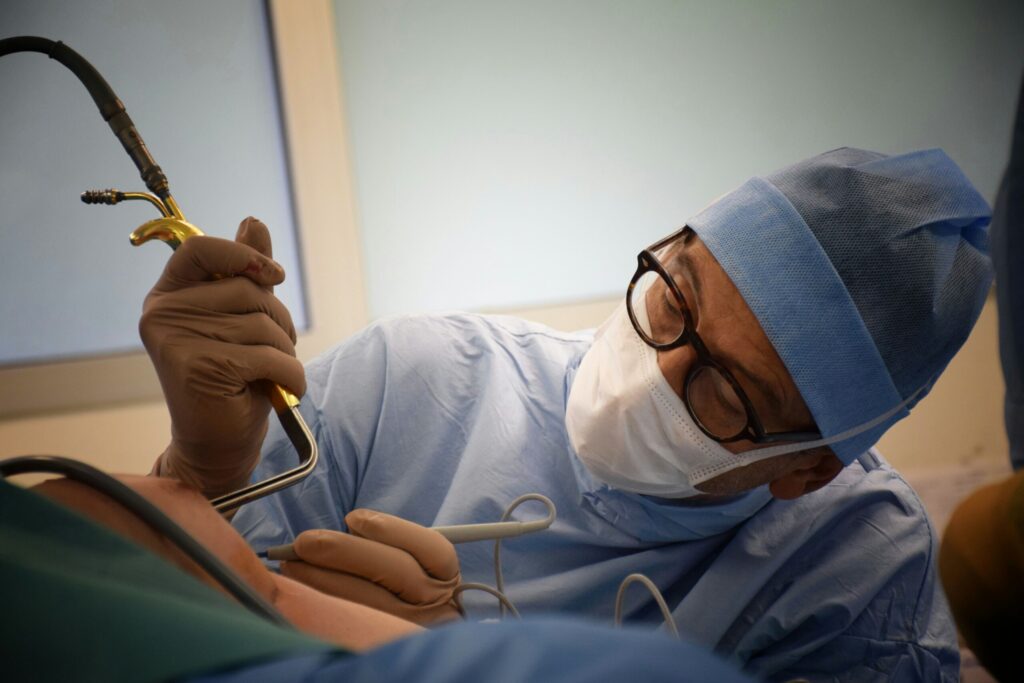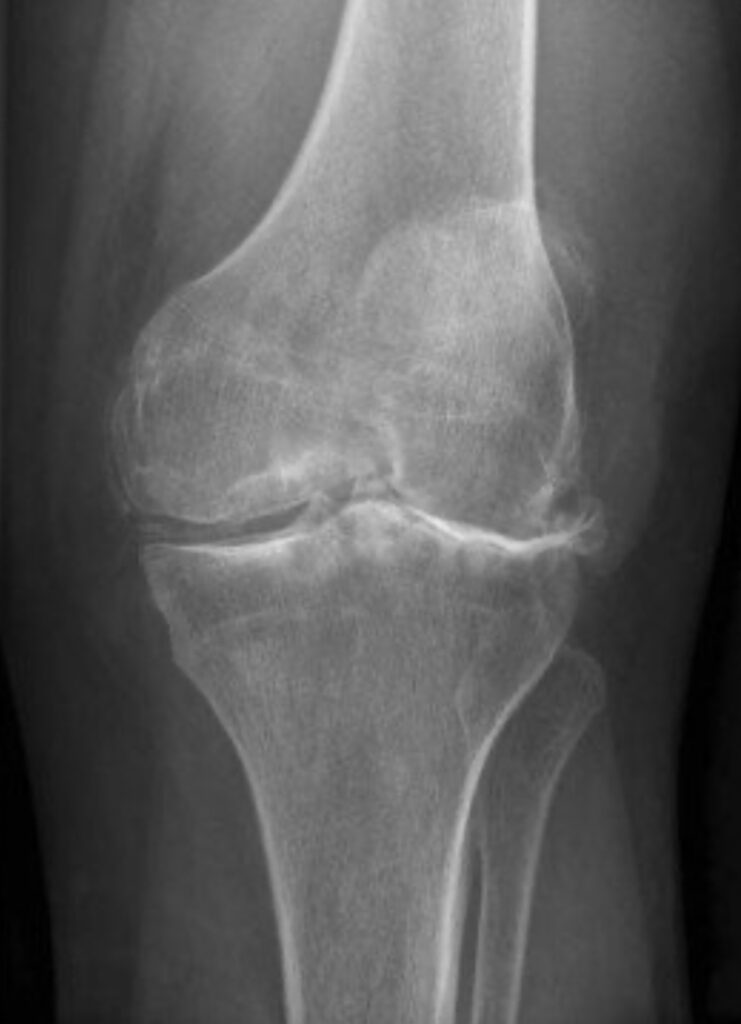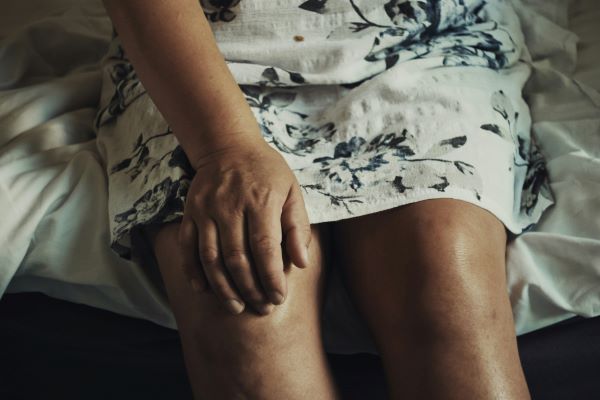People who have knee osteoarthritis will find relief from some activities, while others could make matters worse. Want to stay safe? Follow this guide from the Georgia Knee Institute, highlighting what you can and can't do if you want to relieve your knee pain caused by arthritis.

Knee Pain Relief and Exercise
Somtimes, exercise can help with knee pain relief, even when you have osteoarthritis. But some exercises could cause more pair or make your condition worsen, unless you take proper care. As such, you should take note of your current joint health levels so that you can monitor any changes in your comfort once you begin a new workout. Also, be sure to clear any new routines with your healthcare provider, making sure you:
Do
• Move gently, incorporating stretches and low-impact exercises. Try walking, biking, swimming or light strength training to support joint health and mobility, while building muscles to take pressure off your joints when you move.
• Consider training with a physical therapist to be sure your form won't compromise your joint health. can
• Rest if you feel tired or experience any kind of discomfort.
Don’t
Jump or engage in repetitive or high impact motions, since that could strain your joints and worsen your condition.
Changing the Way You Live
In order to slow or stop disease progression, or reduce your pain levels:
Do
• Reach and maintain a healthy weight, since every extra pound puts addition pressure on the joints, worsening knee osteoarthritis symptoms.
Don’t
Smoke, as the chemicals in cigarettes and tobacco products can damage the connective tissues in your body, making your knee pain worse.
Medication
You can manage mild arthritis pain with medication, but more severe pain will require additional interventions.
Do
try over the counter options such as Aleve, Tylenol or Advil; they can provide relief for intermittent pain. Just be sure to clear any medications with your healthcare provider to ensure safety and to avoid interactions with other medications. YTopical joint pain relievers containing capsaicin may also be helpful.
Don’t
Overuse pain medications, since that can lead to unintended and even dangerous side effects, especially if taken in high doses, or long time periods. If occasional medication isn't providing sufficient relief, it's time to start looking at a medical knee procedure that will provide a longer lasting solution.
Genicular Artery Embolization: Non-Surgical Knee Pain Relief in Atlanta
If you need a non-surgical arthritis treatment that provides superior relief, it's time to consider Genicular Artery Embolization (GAE). This minimally invasive procedure is a great option for those who wish to delay or avoid knee replacement surgery, and you can explore your candidacy by requesting a consultation at the Georgia Knee Institute.
If you've been exploring alternatives to knee replacement surgery, you may wonder about the effects of genicular artery embolization. Recently, a new study updated available data on how long you can expect this procedure to relieve knee pain caused by osteoarthritis. This post reviews the study and shares important information on treating osteoarthritis of the knee.

How Long Do Effects of Genicular Artery Embolization Last?
Here at the Georgia Knee Institute, we provide an alternative to total knee replacement surgery for patients seeking knee pain relief from osteoarthritis. Known as genicular artery embolization (GAE), this minimally invasive procedure is a relatively newer knee osteoarthritis treatment. As such, data on its effects is somewhat limited. However, a recent Journal of Vascular and Interventional Radiology study has just added more information on how long you can expect to enjoy relief after undergoing GAE.
The study follows 40 patients who chose to undergo GAE to relieve their moderate to severe osteoarthritis knee pain. Over the course of two years, participants measured reported their pain scores, and every participant noted ongoing pain relief following their procedure. At the conclusion of the study period, the authors then concluded, "Knee osteoarthritis is a leading cause of adult disability and, until now, most minimally invasive treatment options have been proven to provide only short-term relief, measured in weeks or months. For patients who are not candidates for knee replacement surgery, our study shows that GAE provides durable benefit to many patients, measurable for up to 2 years, a great leap forward in offering this cohort lasting relief."
Exploring GAE in Georgia
The more we learn about how osteoarthritis impacts your body, the more we recognize the role that abnormal synovial blood vessels impact your pain experience. As such, when you undergo GAE and the procedure blocks blood flow to the synovial lining, the effects of genicular artery embolization will include reduces pain and inflammation, along with an improved quality of life.
Have you been told you're not a candidate for knee replacement surgery? Do you want to relieve knee pain without an invasive procedure? Request a consultation with our Atlanta-based interventional radiologists. When you're in the office, we'll explore your GAE candidacy and determine a treatment course to deliver lasting knee pain relief.
There are many ways to treat osteoarthritis knee pain. Options include making changes to your lifestyle, taking medication, having a medical procedure or seeking surgery. Typically, people with severe osteoarthritis choose to undergo knee replacement surgery. However, this can be a complicated procedure. So, before you make a final treatment decision, it's important to research these disadvantages of knee replacement surgery.

Possibility for Complications
Knee replacement surgery is invasive, and thus carries a higher risk for complication when compared to alternative knee osteoarthritis treatment options. Potential complications include infection, blood clots, or even nerve damage. Following surgery, you could face a slow and painful recovery period. Plus, surgery may not result in complete knee pain relief, leaving you seeking revision surgery or other treatments. Now, you can reduce your risk for complications by being aware of the disadvantages of knee replacement surgery, and carefully following post-procedural protocols to maximize your recovery. At the same time, you can do your research and find alternatives that can help you delay or avoid this invasive procedure.
Key Disadvantages of Knee Replacement Surgery
Harder Recovery
After knee replacement surgery, you’ll need months of physical therapy to regain strength and mobility. During this time, you may also be dealing with stiffness, pain and swelling. At least initially, mobility will also be challenging, so you'll need help getting around the house and to post-operative appointments.
Device Limitations
Knee replacements don't last forever. You'll likely need a revision surgery after 15 or 20 years. For that reason, younger individuals may wish to delay surgery for as long as possible, maximizing the lifespan of their new knee once surgery is unavoidable.
Higher Costs
Because surgery requires anesthesia, hospital stays and more, it is typically more expensive than other treatment options for knee osteoarthritis. Talk to your insurance provider and surgeon prior to scheduling a knee replacement procedure to be sure you're prepared to manage the out of pocket expenses.
Lingering Mobility Challenges
Knee replacement surgery is great for pain relief, but it doesn't always restore range of motion fully. You may wish to explore alternative treatments if staying active is your top priority.
Risk for Infection
After surgery, you’ll be at risk for infection. Warning signs include pain, redness and incision site swelling or discharge. Call your doctor right away if any of these concerns develop after surgery.
Alternative Treatment Options for Knee Pain
To avoid the disadvantages of knee replacement surgery and relieve knee osteoarthritis pain, you can come to the Georgia Knee Institute. Our interventional radiologists perform Genicular Artery Embolization, the GAE procedure, offering minimally invasive solutions to painful arthritis inflammation. With this treatment option, we can reduce pain and allow you to delay or avoid surgical knee replacement. Request a consultation at our office to see if you're a candidate for GAE.
Can you run with knee arthritis? The good news is, living with arthritic knees doesn’t mean giving up running or an active lifestyle. With the right tips and strategies, you can effectively manage your pain, improve joint health, and continue enjoying the benefits of running.
Whether you’ve been running for years or just starting, this guide shares practical tips to safely navigate running with arthritis.

Keep reading to learn how you can make running more comfortable and beneficial for your knees and learn valuable techniques to support your overall joint health.
Can I Run With Knee Arthritis?
Yes! Here’s how you can do it safely, comfortably, and ensure the maximum benefits:
Start Slow & Listen to Your Body
Regardless of what kind of exercise you choose with arthritis, your goal should be avoiding injury and disease progression. If you’re running with arthritic knees, be sure to start slowly—choosing a mild pace and limited distance to allow your body to adapt gradually.
As your muscles grow stronger over time, you can increase both speed and duration—just be sure to monitor your knee pain.
When done properly, running should help relieve some knee pain and improve range of motion. The best way to ensure that’s the case is to support your runs with appropriate footwear.
Find the Right Footwear
Successfully running with arthritic knees largely depends on what you wear on your feet—that means when you’re running, exercising, or walking through the rest of your day.
Get rid of old, worn-out sneakers. Osteoarthritis runners should replace their footwear every 300-500 miles to ensure optimal support. Look for shoes with the following features:
- Cushioning: Cushioned insoles or memory foam footbeds can help reduce the impact of running on your knees. Thick, soft soles or gel air cushioning systems can also absorb shock and provide additional support.
- Stability features: Stability features like arch support and a deep heel cup help reduce impact, provide additional support, and keep your foot in a neutral position.
- Comfort: Running shoes should feel comfortable right away, without a breaking-in period. Always try your running shoes on in person, ask for fitting help from an in-store expert, and tell them you have osteoarthritis in your knee.
Aside from carefully selecting your running shoes, one of the keys to successful running with arthritis knee is engaging in cross training.
Cross Train to Build Muscle & Strengthen Joints
Cross training simply means to embrace several types of exercise. Here is a quick rundown of exercises that can be particularly beneficial for osteoarthritis runners:
- Strength training and weight bearing exercises
- These help to strengthen supporting muscles, in turn reducing pressure on your knee joints.
- Swimming or cycling
Consider alternating runs with less intense workouts, like swimming or cycling. These will keep you active while giving your body a chance to recover from the higher impact of running.
Consider Lower Impact Cardio
For some, arthritis in the knee and running helps reduce symptom burden. For others, it can make things worse. If the latter sounds like you, consider alternating your runs with lower impact cardio, like cycling, swimming, walking, or an elliptical trainer.
- Cycling
Cycling is an excellent form of exercise if you have knee osteoarthritis. The movement helps lubricate your joints, reducing pain and improving your range of motion. But it’s important to carefully adjust your bicycle to reduce the chances of experiencing knee pain during exercise.
- Water aerobics
If biking is not your favorite option, water aerobics are a great form of cardiovascular exercise. Water aerobics take all the pressure off tender knee joints, making it a comfortable exercise option for individuals who find running too painful.
If you’ve tried various exercises to strengthen your knee joints and reduce symptoms, but are still experiencing pain, the skilled physicians at Georgia Knee Institute can help.
Safe, Effective Treatments for Knee Arthritis at Georgia Knee Institute
Want to reduce the knee pain of osteoarthritis so that your favorite workouts are less challenging and more comfortable? Explore safe and effective knee osteoarthritis treatments at Georgia Knee Institute.
Our skilled physicians use genicular artery embolization (GAE) to prevent disease progression and reduce stiffness, pain and inflammation without surgery.
GAE targets inflammation in the joint lining, allowing you to delay or avoid knee replacement surgery.
Request a consultation with the Specialists at Georgia Knee Institute to learn if you’re a candidate for this minimally invasive procedure.
Arthritis is often associated with joint pain and stiffness, but not all arthritis is the same. For many, living with arthritis means facing the daily frustration of being unable to do things they once did with ease.
Osteoarthritis (OA) and rheumatoid arthritis (RA) are two common yet distinct forms of this condition, each with a unique set of characteristics and symptoms. Understanding their differences is essential for proper diagnosis and treatment.

Keep reading to learn the differences between rheumatoid arthritis vs osteoarthritis, their symptoms, and how to get proper diagnosis and treatment.
What’s the Difference Between Rheumatoid Arthritis and Osteoarthritis?
Understanding rheumatoid arthritis and osteoarthritis differences can help clarify how these conditions affect joint health and treatment approaches.
Rheumatoid Arthritis
Rheumatoid arthritis (RA) is an autoimmune disease that can occur at any age. It causes the immune system to attack the lining of the joints, often affecting several joints at the same time. This disease can flare up or go into remission, and it is typically managed with treatment.
Osteoarthritis
Osteoarthritis (OA) is a progressive disease caused by age-related wear and tear. It develops when the cartilage between your joints breaks down or wears away, causing pain and physical changes in the surrounding joints and bones.
What’s the main difference in osteoarthritis and rheumatoid arthritis? The main difference lies in what causes the joint damage.
RA develops due to a malfunctioning immune system, whereas OA is more common among older adults and results from wear and tear on the joints.
If you or a loved one struggles with joint pain, review the symptoms below to help you understand which type of arthritis could be causing it.
How Is Osteoarthritis Different From Rheumatoid Arthritis: Symptoms
When trying to identify rheumatoid arthritis vs osteoarthritis symptoms, knowing what to look for is key. Let’s explore the symptoms of each:
Osteoarthritis Symptoms
The first joints impacted with OA are typically those in your spine or hands due to more usage over time.
Joints that bear weight are also likely to be impacted early on, making hip and knee osteoarthritis some of the most likely conditions to be diagnosed first. Let’s explore the difference in osteoarthritis and rheumatoid arthritis symptoms:
- Knee, hip, neck, back, toes, and thumb joint pain, often worsened by activity and relieved by rest.
- Stiffness in affected joints (especially after inactivity or in the morning).
- Swelling and tenderness in affected joints.
- Decreased range of motion in affected joints.
- Grating sensation when the affected joint or joints are moved.
- Bone spurs around the affected joints.
Rheumatoid Arthritis
With RA, joint symptoms can accompany fatigue, low-grade fevers, limited appetite, or even nodules (lumps that form under your skin).
Unlike OA, RA impacts smaller joints in the feet, hands, shoulders, elbows, ankles, and knees, often impacting multiple joints symmetrically (both sides of the body). Common symptoms include:
- Joint swelling or dysfunction at any time of day.
- Cracking, popping, or grinding sounds when moving the affected joints.
- Changes in joint shape over time, especially in the fingers and toes.
Rheumatoid Arthritis vs Osteoarthritis: Risk Factors
Knowing each condition’s risk factors can be an extremely helpful first step in getting a proper diagnosis.
OA risk factors include:
- Being an older adult.
- Having sustained a previous joint injury.
- Overusing your joints.
- Carrying excess weight.
- Having a family history of osteoarthritis.
RA risk factors are less evident, but may include:
- Being a woman.
- Being a smoker.
- Exposure to certain chemicals (e.g., asbestos, pesticides, and silica).
- Carrying excess weight.
- Having a family history of the disease.
Now that you understand the difference between RA and OA, let’s discuss treatment options.
Rheumatoid Arthritis vs Osteoarthritis: Treatment Options
Unfortunately, there is no known cure for arthritis, and joint damage cannot be reversed. However, proper diagnosis and treatment can help ease your pain and improve joint function.
The primary goal of rheumatoid arthritis vs osteoarthritis treatment is to stop your immune system from attacking your joints.
To that end, RA is usually treated in the following ways:
- Biologic or disease-modifying medications designed to stop disease progression.
- Pain relievers and non-steroidal anti-inflammatories to ease pain and swelling.
- Weight loss to help reduce symptom burden.
Similarly, OA is commonly treated with:
- Pain relievers and non-steroidal anti-inflammatories.
- Weight loss and supervised exercise programs to help reduce symptom burden.
However, many with OA will also need medical intervention to address the disease, particularly when major joints like the hips or knees are impacted.
In the past, that often meant surgically replacing your damaged joint. But today, patients with knee osteoarthritis have a different treatment option: the genicular artery embolization (GAE) procedure.
Consider GAE for Arthritis Pain at Georgia Knee Institute
GAE is a minimally invasive procedure that reduces blood flow to the joint lining to treat the pain and inflammation of knee osteoarthritis.
This is an ideal option for knee OA sufferers who haven’t found relief from lifestyle modifications or medications. GAE helps you address your disease without surgery, or overnight hospital stays.
Want to see if you’re a candidate for GAE? Request a consultation with the Georgia Knee Institute to learn more about this innovative treatment option.
At the Georgia Knee Institute, our Atlanta-based interventional radiologists ease arthritis pain in your knee with Genicular Artery Embolization (GAE.) This minimally invasive procedure reduces inflammation and pain in the synovial lining of the knee. And it does so by limiting the flow of blood to the area. As a relatively new procedure, long-term GAE data is limited. But, the evidence we do have? It's looking pretty promising! Let's take a closer look.

How Well Does GAE Ease Arthritis Pain in the Knee?
Three years ago, at the 2021 Society of Interventional Radiology’s Annual Scientific Meeting, researchers presented findings on how patients' could still ease their arthritis pain one year after undergoing the GAE procedure. Researchers followed 40 adults, aged 40 to 80, all of whom were livingwith mild to moderate knee osteoarthritis. This is what they discovered.
One full year after having the GAE knee procedure, study participants reported a 63% decrease in personal pain. Plus, they recorded a 60% reduction on the WOMAC osteoarthritis index score. (Also known as the Western Ontario and McMaster Universities Arthritis Index, this index assesses hip and knee osteoarthritis progression by recoding experienced stiffness, pain and challenges to physical function. If your score is lower, that means you've been able to ease arthritis pain and limits on mobility.)
Best of all, no study participant experienced major side effects after having GAE. And adverse events that did occur were mild and self-resolving, for the most part. Combined with the fact that each patient's procedure was 100% successful from a technical standpoint, Dr. Siddharth A. Padia, lead study author, said that GAE gives interventional radiologists “the potential to completely disrupt and change the way patients are treated with knee osteoarthritis.”
Finding Osteoarthritis Knee Pain Relief in Georgia
Want to secure knee pain relief without invasive knee replacement surgery? Genicular Artery Embolization at the Georgia Knee Institute could be the ideal treatment option. Find out if you're a candidate by [tx-appt-link] requesting a consultation [/tx-appt-link] with our experts.
If you’re living with knee osteoarthritis pain and exploring treatment options, you'll probably compare genicular artery embolization vs knee surgery. But what are these procedures? And how can you tell which is your best treatment option? Keep reading for all the details.

Exploring Knee Surgery
During knee replacement surgery, damaged bone and cartilage is removed from the kneecap and some surrounding areas. Next, it's replaced with a plastic or metal artificial knee joint, built to replicate a natural knee's movements.
Now, this is an invasive procedure that requires general or regional anesthesia. But the surgery is not lengthy, typically lasting between one and two hours. After the procedure, doctors will close your incision site with sutures or staples before dressing the wound. As such, you’ll have to care for your wound during the recovery period, while following all other post-operative instructions from your doctor.
What is Genicular Artery Embolization
What's different about genicular artery embolization vs knee surgery? Unlike surgical procedures, genicular artery embolization (GAE) is minimally invasive. And, instead of replacing your knee, it reduces knee osteoarthritis pain and inflammation by limiting blood flow to the knee's lining. This knee procedure also lasts between one and two hours, but it is an outpatient procedure, so you can be mildly sedated instead of undergoing general anesthesia. Also, instead of a large incision, our interventional radiologists insert a catheter through a small opening into the artery. Then, with the help of X-ray guidance, it's positioned to access your knee lining. Once in place, we inject the catheter with tiny particles that block blood flow to the area, providing an extended period of knee pain relief following the procedure.
Genicular Artery Embolization Vs. Knee Replacement Recovery
After knee replacement surgery, most patients spend between one and three nights in the hospital. The recovery period is also extensive, lasting up to a full year, though most people resume normal activities at the six week post-operative mark. Also, many patients need physical therapy to fully recover, and face significant pain following their procedure.
In contrast, the genicular artery embolization recovery period is much shorter. You will likely go home on the same day as your procedure, and can get back to light activities about one week later. It's normal to experience some discomfort in the first days after GAE, but that will be temporary, and knee pain relief should become apparent within two weeks of the procedure.
Finding the Best Osteoarthritis Knee Pain Relief
Choosing betweem genicular artery embolization vs knee surgery? Consider this: knee replacement surgery provides lasting relief. But it requires a stay in the hospital and an extended rehabilitation period, as well as higher risks for complications. Also, you must be cleared for surgery in order to choose this treatment option.
Now, if you choose GAE at the Georgia Knee Institute, you'll get months or even years of knee pain relief, along with improved mobility. And that will come without hospital stays or general anesthesia, or risks for serious complications. Plus, you undergo multiple GAE procedures, allowing you to delay or avoid surgery. Want to learn more about GAE in Georgia? Click here to request a consultation
Knee osteoarthritis is a progressive disease. And that means that your mobility could be compromised and your symptoms will worsen as time passes. In fact, we classify your osteoarthritis symptoms in four stages. And identifying problems at an earlier stage can help you seek earlier interventions and delay or prevent progressions.
Understanding Knee Osteoarthritis

Knee osteoarthritis impacts both joint function and mobility. It is an incurable, progressive disease. Diagnoses come in stages that are dependent on symptoms and joint damage. Early intervention can help your preserve mobility; it may also help prevent or delay progression.
Stage 0
This stage means you have a healthy knee with no symptoms of arthritis. You will not show any signs of joint damage, and won't need any intervention to stay active and pain-free.
Stage 1: Minor Knee Osteoarthritis
Here, knee joints can show signs of minor wear and tear. There may be small signs of bone spur growth on joints, but most stage 1 patients don't experience knee pain. At this stage, you may wish to engage in knee health exercises, as that could help prevent disease progression.
Stage 2
Here, there will be more noticeable signs of bone spur growth on knee joints. While the space between joints should still appear normal, stage 2 knee osteoarthritis is likely to leave you experiencing joint pain and stiffness. (These symptoms will likely be worse after you exercise, sit for extended periods of time, or when getting out of bed in the morning). At this stage of progression, cartilage could also start breaking down. You may be able to manage progression and pain with lifestyle measures. However, you may need additional interventions for relief.
Stage 3: Moderate Knee Osteoarthritis
Stage 3 patients display obvious erosion of cartilage and a narrowing of the gap between bones. Joint inflammation causes stiffness and pain, and your knees may pop or make a snapping sound with walking. Pain medications may help with symptom management, but many patients will need to seek additional interventions.
Stage 4
This severe knee osteoarthritis has caused joint stiffness due to significant cartilage erosion. There will also be very little space between your bones, and decreased levels of synovial fluid will lead to pain and friction with joint movement. As a result, once your disease progresses to stage 4, it will be difficult to complete even your simplest daily tasks. In fact, many patients turn to surgical treatment at this stage. But, if you seek medical interventions for stage 2 or 3 knee osteoarthritis, our Georgia Knee Institute team can treat your condition without surgery.
GAE for Stage 2 and 3 Knee Osteoarthritis
Genicular artery embolization (GAE) is a non-surgical medical procedure. It can slow the progression of knee osteoarthritis, and is a procedure best suited for treating people with stage 2 and 3 osteoarthritis who don't find relief from other, non-surgical interventions. The procedure reduces symptoms by diminishing blood flow to the knee lining. After the GAE procedure, most patients can walk within two to three hours, and usually return to normal activities the next day. Apparent symptom relief usually appears within a few weeks?
Ready to learn more about GAE for knee osteoarthritis? We’re here to help. Click here to request an appointment at the Georgia Knee Institute.
If you want to explore non-surgical treatment for knee pain, you may be wondering if these options provide effective relief. That's especially true if you can't or prefer not to undergo a surgical procedure like a total knee replacement. So, can you say goodbye to pain without going in for an operation? Keep reading for all the important details.

Understanding Non-Surgical Treatment for Knee Pain
Years ago, if you wanted non-surgical treatment options for knee osteoarthritis you could switch up your lifestyle or take medication. Initially, these options were quite effective; however, if your arthritis pain was moderate to severe, you were unlikely to experience relief without surgery.
Today, thanks to innovations in interventional radiology, you can treat your knee pain with minimally invasive Genicular Artery Embolization. And, with the emergence of new studies like those presented at the recent annual meeting for the Society of Interventional Radiology, we know that GAE significantly reduces pain for patients with knee pain due to osteoarthritis. In fact, we know that the procedure is especially beneficial for patients who are 50 years of age or older.
When presenting these findings, MedStar Georgetown University Hospital physician Kaitlin Carrato said, "We know this treatment has clear benefits in reducing pain and improving the ability to do everyday activities for patients. But now that we know it's particularly helpful for those over 50 years old, it may mean that those with chronic pain conditions, like arthritis, would benefit more from this treatment than patients suffering acute pain, such as an injury."
Do you want to learn more about non-surgical treatment for knee pain? Hoping to treat osteoarthritis of the knee without sleeping in the hospital or dealing with knee replacement surgery? Come learn more about the GAE procedure in Georgia by clicking here to request an appointment today.
Walking backward is trending on Tik Tok. Proponents claim it's a miracle cure for everything from running injuries to boredom when exercising. But, recently, reports have emerged that it can also help manage knee pain due to osteoarthritis. Could that be true? Keep reading to find out!

Walking Backward for Knee Pain
When you have knee pain due to osteoarthritis, you may suffer additional symptoms including, stiffness, swelling and limited mobility. As such, many people seek medical interventions such as Genicular Artery Embolization to relieve their arthritis pain without surgery.
However, since some patients prefer to manage arthritis with non-invasive lifestyle treatments, interest in walking backward is growing steadily. But how can this exercise help? Here's the story: moving backward engages different muscle groups, quickly relieving joint pressure in the knees.
Specifically, this form of movement engages the muscles in your quadriceps. And, in doing so, you can give your knee muscles a good stretch, helping boost mobility and reduce pain. Ready to give this workout to relieve arthritis pain a try? Remember that you're more likely to fall or trip when walking backward. So go slow, train indoors, and walk with supervision whenever possible.
Going Beyond the Relief of Walking Backward
Lifestyle interventions such as exercise typically work well for patients with mild to moderate knee arthritis pain. But once your condition progresses, you will likely need a medical intervention to relieve your knee pain.Ready to relieve your pain but want to avoid surgery? Click here to request an appointment at the Georgia Knee Institute to see if you're a candidate for genicular artery embolization.






